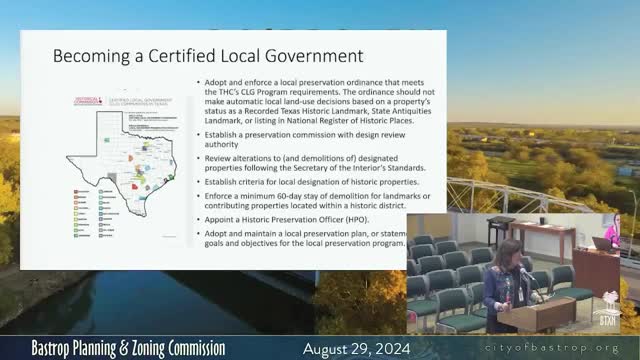New regulations spark debate over property rights and aesthetics
September 04, 2024 | Bastrop, Bastrop County, Texas
This article was created by AI summarizing key points discussed. AI makes mistakes, so for full details and context, please refer to the video of the full meeting. Please report any errors so we can fix them. Report an error »

During a recent government meeting, officials discussed the complexities surrounding nonconforming properties and the challenges faced by homeowners in retrofitting existing structures. A key point of contention was the impact of grandfathered regulations on property owners, particularly when repairs or modifications are necessary.
The discussion highlighted that homeowners with nonconforming structures, such as fences, may face significant hurdles when attempting to rebuild or repair. For instance, if a storm damages a fence, the homeowner may be required to adhere to current codes that impose stricter aesthetic and height regulations, which could differ significantly from the original structure. This was illustrated by an example where a homeowner was unable to replace a five-foot fence with a similar design, as current regulations mandated a three-foot semi-transparent fence.
Officials noted that any repairs exceeding 50% of the structure's value would require compliance with current standards, necessitating a certificate of appropriateness from the Historic Landmarks Commission (HLC) before any work could commence. This process aims to ensure that modifications align with the character of the district, although it may create additional burdens for homeowners.
The meeting also addressed the financial implications of these regulations, with the cost of obtaining a certificate of appropriateness currently around $60, a significant reduction from previous variance fees that could exceed $5,000.
In terms of public engagement, officials emphasized the importance of educating residents about these processes should the proposed regulations move forward. They outlined plans for at least three public hearings and extensive outreach to ensure community input on potential district boundaries and regulations.
Lastly, the conversation touched on the absence of minimum lot size requirements in new developments, with officials expressing a desire to revisit this issue in future discussions. The meeting underscored the ongoing challenges of balancing regulatory compliance with the needs and rights of property owners in the community.
The discussion highlighted that homeowners with nonconforming structures, such as fences, may face significant hurdles when attempting to rebuild or repair. For instance, if a storm damages a fence, the homeowner may be required to adhere to current codes that impose stricter aesthetic and height regulations, which could differ significantly from the original structure. This was illustrated by an example where a homeowner was unable to replace a five-foot fence with a similar design, as current regulations mandated a three-foot semi-transparent fence.
Officials noted that any repairs exceeding 50% of the structure's value would require compliance with current standards, necessitating a certificate of appropriateness from the Historic Landmarks Commission (HLC) before any work could commence. This process aims to ensure that modifications align with the character of the district, although it may create additional burdens for homeowners.
The meeting also addressed the financial implications of these regulations, with the cost of obtaining a certificate of appropriateness currently around $60, a significant reduction from previous variance fees that could exceed $5,000.
In terms of public engagement, officials emphasized the importance of educating residents about these processes should the proposed regulations move forward. They outlined plans for at least three public hearings and extensive outreach to ensure community input on potential district boundaries and regulations.
Lastly, the conversation touched on the absence of minimum lot size requirements in new developments, with officials expressing a desire to revisit this issue in future discussions. The meeting underscored the ongoing challenges of balancing regulatory compliance with the needs and rights of property owners in the community.
View full meeting
This article is based on a recent meeting—watch the full video and explore the complete transcript for deeper insights into the discussion.
View full meeting
